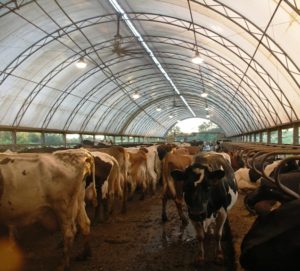SPDES and On-Farm Construction
When planning an agricultural construction project, do not fall into the myth of agricultural exemption a general permit for stormwater discharge may be required.
by Doug Kierst and Judy Wright
When planning construction in your farmstead or farm area, is one of the first considerations whether you should obtain a NYS Pollutant Discharge Elimination Permit (SPDES) General Permit for Stormwater Discharges from Construction Activity (GP-0-15-002)? Many farms incorrectly assume a SPDES Stormwater Permit is only needed for non-farm construction and incorrectly assume that farm construction is exempt! Do not fall into this easy assumption and potentially suffer fines and penalties.
We have run into farms that are not aware of their need to obtain a SPDES Stormwater Permit and may not be told during the planning process by the project engineer, unless they know to ask. We see and hear of inadvertent violations like this, frequently. So why bring this to your attention now? Many of our rural communities that have been traditionally agriculture are changing. Newcomers to these communities are concerned about their surroundings and are asking questions of their town planning committees and boards.
New York State Department of Environmental Conservation (DEC) views barns and other large farm construction projects including buildings, silos (including bunks), houses, stock yards and ponds, as construction projects that may require a SPDES Stormwater Permit.
How do you know when you need to obtain a SPDES Stormwater Permit? It will depend on the type of construction activity that is proposed. Information can be found on the DEC website; you may also contact the NYS DEC Regional Office, your county Soil and Water Conservation District or county Cornell Cooperative Extension offices for additional assistance.
If you are planning to complete any farm construction, this activity most likely will trigger soil disturbance. The outline below is intended to alert you to the requirements for permitting.
Soil disturbance of less than 1 acre: If you are disturbing less than 1 acre, it is not required to obtain permit coverage, however, water quality standards must be maintained to prevent soil from leaving your site and entering a watercourse. The DEC can still issue a fine if a water quality violation occurs on the site, even if no permit is required.
Soil disturbance is between 1-4.99 acres – “Exempt Activities”: If you disturb between 1 and 4.99 acres, most (NOT ALL) practices are still exempt from permit coverage. However, exempt projects and activities are still required to implement erosion and sediment controls during construction, but there are no requirements to implement post-construction stormwater controls.
Soil disturbance is between 1-4.99 acres – “NON-Exempt” Activities: If you disturb between 1 and 4.99 acres, and the construction activities include the construction of barns, houses, silos (including bunks), stock yards, pens, farm ponds and other farm buildings, a SPDES Stormwater Permit is required. A stormwater pollution prevention plan (SWPPP) that includes erosion and sediment controls is also required to be developed and implemented.
Soil disturbance of over 5 acres: Construction activities involving 5 or more acres of disturbance must obtain a SPDES Stormwater Permit and develop and implement a SWPPP that includes erosion and sediment controls. For sites that include the construction or reconstruction of impervious area, the SWPPP must also address post construction stormwater management practices.
All sites that require a SPDES Stormwater Permit, also need a completed Notice of Intent (NOI) form which must be submitted to the DEC prior to the commencement of soil disturbance activity. Soil disturbing construction activities, as defined by the Stormwater Permit, means any clearing, grading, excavation, filling, demolition or stockpiling activities that result in soil disturbance. Clearing activities can include, but are not limited to, logging equipment operation, the cutting and skidding of trees, stump removal and/or brush root removal – if site clearing is completed for a non-exempt practice, a stormwater permit is needed. Clearing completed for a field that will be used agricultural crop production does NOT need a stormwater permit. However, it is strongly recommended that erosion and sediment controls are implemented during large clearing activities. Construction activity does not include routine maintenance that is performed to maintain the original line and grade, hydraulic capacity, or original purpose of a facility.
It is always easier to ask a question about stormwater control prior to starting a construction project rather than waiting until a potential violation is noticed and then deal with permitting and possible costly fines, increasing the cost of the project. For more information you can consult DEC’s website.


